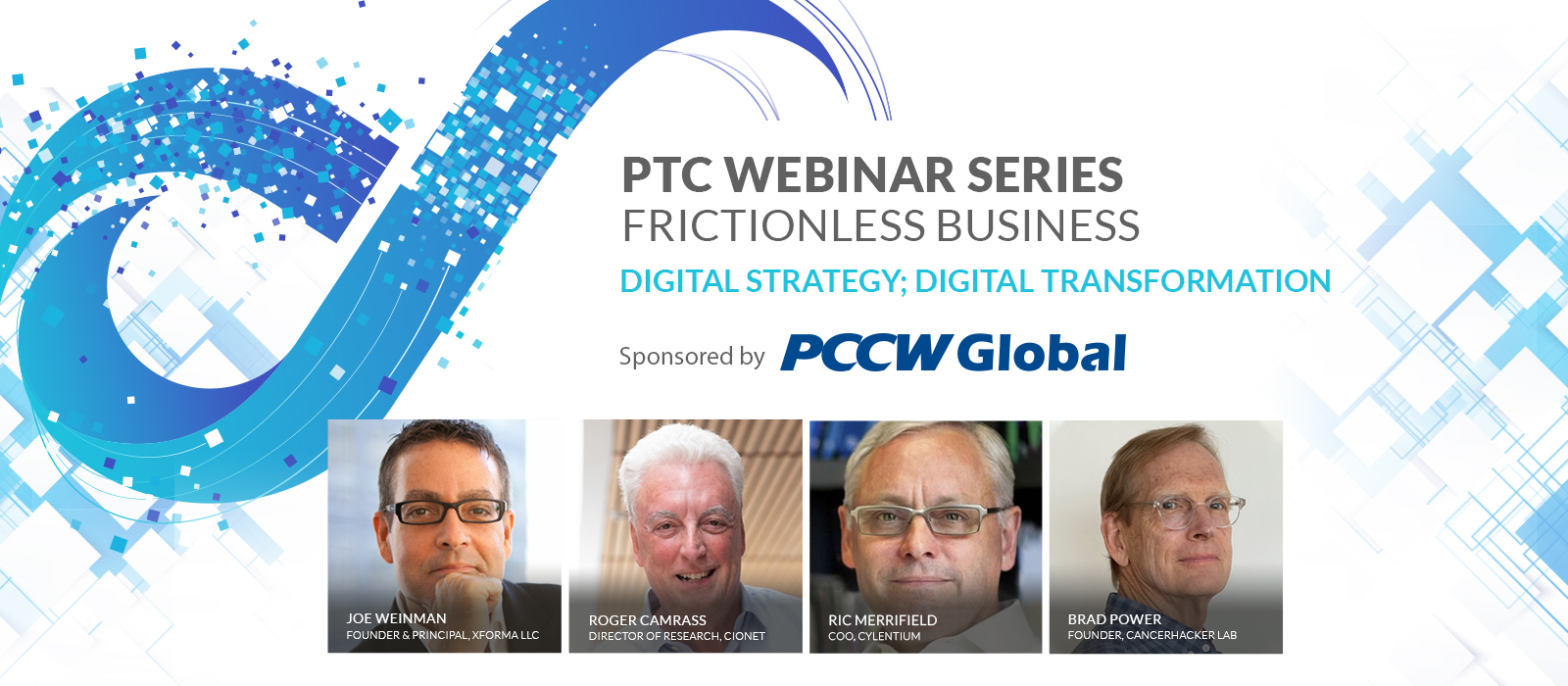A few weeks ago, I had the pleasure of moderating a panel as part of the PTC Webinar Series: Frictionless Business. The topic we addressed in depth was “Digital Strategy; Digital Transformation.” Digital strategy addresses how to exploit digital technologies to enable competitive advantage and enhance stakeholder benefits. Digital transformation is the act of implementing the strategy, typically rethinking and transforming not only IT systems but related dimensions of the enterprise such as customer journeys and digitalized products and services.

The panelists included Roger Camrass, the director of research for CIONET, who has worked with numerous CIOs across Europe in virtually every industry; Ric Merrifield, currently COO of Cylentium, who has led a number of engagements with companies such as Disney for MagicBands and Starbucks for customer experience and mobile ordering; and Brad Power, currently the founder of CancerHacker Lab, who is a frequent contributor to the Harvard Business Review and has also led numerous engagements with top global firms.
First, some background. IT spending is projected to increase by 8% this year, partly as a result of the global economic recovery but also due to corporate investments in using IT to enable improved and reengineered customer relationships, experiences, and journeys, which I call collective intimacy; streamlined processes with asset-light resourcing and new organization structures, or information excellence; new smart, digital, connected products, services, platforms, and ecosystems, i.e., solution leadership; and accelerated innovation, through crowdsourcing, idea markets, innovation networks, and, increasingly, machine innovation, whether in world champion Go-playing software, or designing quantum physics experiments.
There are two major themes underpinning these initiatives.
First, a recognition that digital strategy must enable and align with business strategy. Digital strategy is not about a better email system or conference room reservation system but about using IT and digital to create differentiated value for customers to create strategic advantage. At one extreme, sure, IT can be very mundane. But at the other, it can be strategic, or even existential, as Borders and Blockbuster discovered. In any case, as the panelists observed, the business goal or problem must be clear. While some use the term digital transformation to mean a new or upgraded CRM or ERP system or a move to the cloud, the height of digital transformation is in its ability to implement a new digital strategy that supports a major shift in business strategy.
The second, related, theme is that new network-centric technologies – such as 5G, edge, cloud, and AI – are enabling organizations to not only reduce cost, but to grow revenue by rethinking their infrastructure, digitalized products and services, and customer experience, and then by renewing and transforming all dimensions of their people, processes, and technologies. A good example of digital transformation in the transportation industry is ride-sharing services. They didn’t just use 3G or 4G to enable a better phone call to the taxi dispatcher, i.e., implement an incremental, sustaining innovation. Instead, they used mobile apps, GPS, and real-time route planning to enable a completely transformed customer experience, including creating an ongoing relationship with customers, maintaining credit card details across transactions, enabling notification regarding the time for the ride to arrive, and so forth.
However, as the panelists pointed out, while transformation sounds great in principle, the reality is that legacy companies have had difficulty in creating shareholder value through digital, leaving the greatest portions of industry profit pools to the new digital entrants. There may be a number of reasons for this: scale, legacy processes, skills deficits, resource allocation processes, the well-known “innovators dilemma” and difficulty in disrupting one’s own profit formula, and the like.
Moreover, a successful approach requires a clear goal – not just using technology for technology’s sake. As Camrass wryly observed, all too often, the viewpoint has been “technology is the answer, so, what was the question?” Conversely, technology can emerge as a solution to a problem that, at first glance, may appear to have nothing to do with technology. For example, as Merrifield pointed out, Disney implemented MagicBands as a means of increasing the duration of customers’ stays. However, they realized that they couldn’t succeed without external skills acquisition. On the other hand, Power says that GE, even despite a large investment in digital technologies, appears to have not met their goals for value creation. And, as Camrass argues, despite billions of pounds of investments in “track-and-trace” for COVID-19, the UK was not successful in timely deployment due to lack of skills and capabilities to build a system in the time frame that the pandemic required. Moreover, the competition for digital talent acquisition is fierce, with many recent graduates much more interested in working for digital natives than incumbents.
This is not to say that digital strategy, innovation, transformation, and disruption are easy for digital natives either. Even though many of them have a reputation for innovation, they have all too often merely appropriated technologies without permission from start-ups or their peers; bought their way in to markets by acquiring companies; or often, dismally failed to gain traction despite years of large investments. Many companies – digital native or legacy – claim to be innovative, but as Power observed, it is rare to find an organization that fully embraces a spirit of continuous innovation. And, even with repeated reinvention, one missed market transition can lead to their permanent demise.
The panelists agreed that most CIOs will say that digital transformation is all about culture, communications, engagement, and success narratives, not about technology. Simple analogies and pilot projects, for example, can help staff fully appreciate the value of specific initiatives. Still, solving culture challenges is not easy. Power and Merrifield pointed out that creating or acquiring an independent, arms-length unit with the right scale and culture can help, and this culture can sometimes successfully be integrated into the core organization; but sometimes can create massive organizational tension.
The webinar goes into much more depth that this brief overview can possibly cover. To watch these globally renowned experts share their insights and best practice methodologies, please view the September webinar “Digital Strategy; Digital Transformation” here:
Mark your calendar for next month’s webinar “Digital Strategy; Digital Transformation” on Wednesday, 15 September 2021 at 14:00 Hawaii Standard Time.
To learn more about the upcoming PTC Webinar Series, visit https://www.ptc.org/ptc-webinar-series/#upcoming.






























